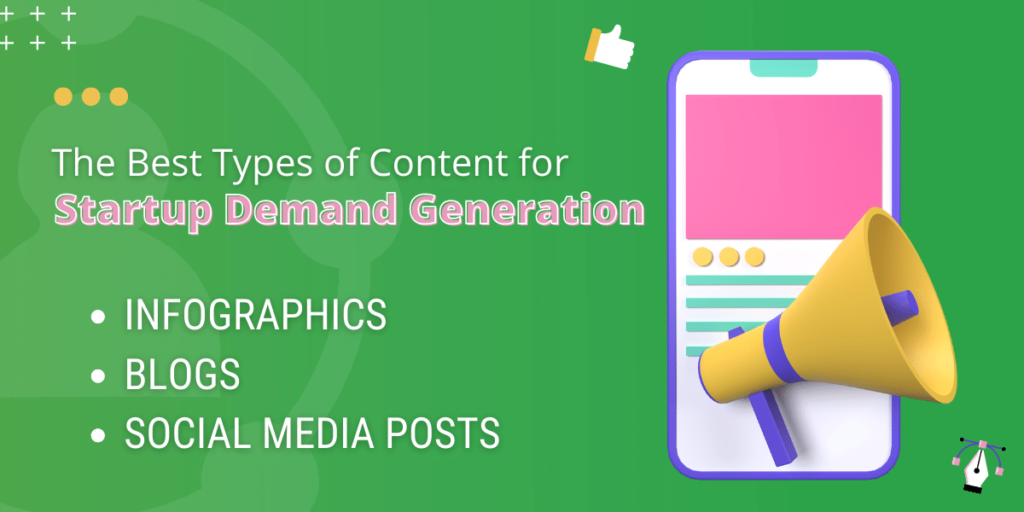How Startups Can Use Content For Demand Generation
Startup companies often face a tidal wave of challenges after launch. Between deciding how to balance and allocate investor funds, struggling with effective sales strategies, and finding the right people to help grow the company. Marketing can end up low priority.
Creating content can seem frivolous when compared to the myriad of other startup tasks, but it could be exactly what a new company needs to gain traction and scale up quickly.
How do you identify a proper audience and reach people who need your product or service? The key to creating leads that are legitimate is in demand generation, using content.
What is Demand Generation?
In simple terms, the goal of demand generation is implied by the phrase itself: generating demand for something. But there are complexities to demand generation that extend beyond simply creating demand. Effective demand generation should result in lasting relationships and long-term engagement.
The goal of marketing strategies for companies at any stage of development is to increase brand awareness, generate leads, turn leads into sales, and foster continued brand loyalty. Demand generation can help your startup set off on that marketing journey by developing an audience.
Demand Generation for Startups
The secret sauce in demand generation for startup companies is education. When you’re just starting out, consumers don’t know anything, or very little, about who you are and what you offer.
To understand how you should educate potential customers to create awareness, ask yourselves these questions:
- What problems does your startup help solve?
- What makes you different from competitors in your industry?
- Why should a potential customer trust your brand?
- What can you tell potential customers that will keep them coming back?
The 3 Stages of Content Marketing Demand Generation
So, where should you start? We’ve broken demand generation into four easy steps to get you moving in the right direction.
Planning
Before you do anything else, take some time to write out specific goals for your company and marketing efforts in particular. Start broad and fill in specific campaign strategies based on what would best achieve your goal. Marketing campaign goals could include increasing brand awareness, generating leads, and elevating brand perception.
Defining Your Audience
This one may be tricky because you don’t have a well-defined audience yet, but you can approach this step with a goal-forward perspective. Who would your ideal customer be? Be specific and include demographics such as age and gender, level of income, and industry or hobby involvement. What are the stress points in these people’s lives? What does your brand offer that can address these stressors?
Understanding the group of people you want to reach with marketing efforts will help you build out campaign strategies with precision. The more detailed these brand personas become, the better.
As you implement strategies and measure results, you can adjust these personas to better fit the actual audience your startup is reaching.
Creating Content
This is the step that is the most difficult for startups to prioritize: creating the pieces of content that will be distributed. It’s time-consuming, takes a lot of creativity, and can seem like something unimportant, but it’s an essential step to generating demand.
Content marketing provides your brand with touchpoints that can be shared on your website, social media handles, email campaigns, and more. Approach your content creation as a multi-faceted tool that can continuously generate demand for your brand.
Measuring Results
You’re just starting out, so every marketing effort you try should be thought of as an experiment. Set up a regular cadence to go back and look at how content marketing campaigns have performed. This could mean comparing results to your initial goals, tracking follower growth on social media accounts, or quantifying leads. Be critical in how you examine what worked and what didn’t work and adjust accordingly.
Take a look at the demographics of the people your content actually reached compared to who you were hoping to target. It’s possible you had your “ideal customer” wrong, and you need to shift your content strategy to better fit a different demographic. Effective campaign adjustments can lead to successful demand generation.
The Best Types of Content for Startup Demand Generation
Here are a few ideas for types of content that are best for startup demand generation:
Infographics
Infographics are great for providing people unfamiliar with your brand with detailed information about what you offer in an easily-digestible format. Infographics can include statistics, how-to product descriptions, and brand information that educates consumers without being too “salesy”.
Infographics are versatile pieces of content in that they can be shared on the website, reformatted to fit social media dimensions, and distributed in email campaigns. Plus, with tools such as Canva at your fingertips, they are easy to create.
Blogs
Blogs provide prospective customers with long-form content that can teach them more about your product, your brand’s story, and your industry as a whole. There is much room for creativity in the content your blog contains, and each post certainly doesn’t need to be a sales pitch for your startup.
Blog content should contain keywords that are relevant to your brand. This is important for optimizing your site so that it shows up in search results when prospective customers are seeking information related to what you offer. Search engine optimization (SEO) is just one content marketing strategy that can propel your brand in front of new customers.
Social Media Posts
Customers expect different things these days before choosing to make a purchase, and some research has shown that it may take more than 7 touchpoints before an online customer will convert.
Linking your social media profiles to your website can create a cyclical experience for customers who need a little more info about your brand before deciding to buy. They may click over to your brand’s Instagram from the website to see your product in action, and then link back to the website to view more products. They could follow your account and see new content being posted as a consistent reminder that you exist.
The key is frequently adding new content to your social media accounts – even when your following is still small. In one study, 91% of surveyed consumers said they visit the brand’s website or app when they follow them on social media. What are consumers looking for when following a brand’s social media account? Customer service responses, engagement with their audience, transparency, and memorable content. All of these characteristics should guide your startup’s social media strategy.
Ready to boost your demand generation with content? Request a consultation today!
Frequently Asked Questions
What is a demand generation platform?
A demand generation platform is utilized to drive awareness and boost interest in a company's product or services. These platforms can measure lead capture and lead nurturing to ensure that users are moving through the funnel correctly.
What are the types of demand generation?
Some types of demand generation include content marketing, lead nurturing, inbound marketing efforts, and campaign optimization.
What is the difference between demand generation and growth marketing?
Growth marketing references the macro component of traffic and revenue generation, while demand generation focuses on a specific part of the of the journey. Growth marketing is a more holistic approach compared to demand generation which is a more pinpoint approach.



